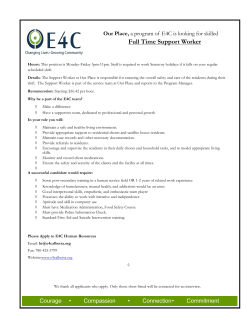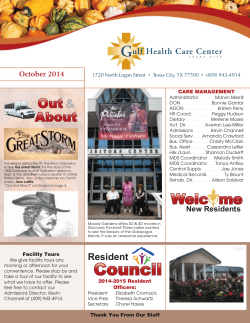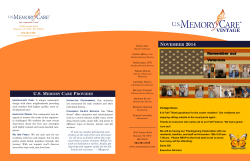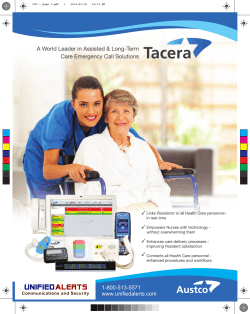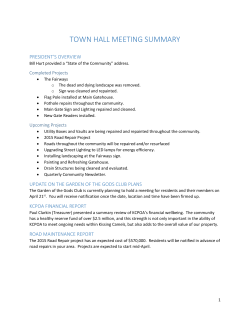
Understanding CASPER Reports - Mountain
Disclaimer Peer Coaching: Leaders of Change Nursing homes should always use: Part 3 – Understanding CASPER Reports 0Q lit M ’ M • MDS 3 3.0 Quality Measures U User’s Manuall (QM) • Resident Assessment Instrument User’s Manual (RAI) • Quality Measure Identification Number by CMS Reporting Module (QMID) • Five-Star Quality Rating System Technical Users’ Guide Resources What Is CASPER Data? Five-Star Quality Rating System Technical Users’ Guide: http://www.cms.gov/Medicare/Provider-Enrollment-andCertification/CertificationandComplianc/FSQRS.html • CASPER = Certification and Survey Provider Enhanced Reporting MDS 3.0 RAI Manual: http://www.cms.gov/Medicare/Quality-Initiatives-Patienthtt // /M di /Q lit I iti ti P ti t AssessmentInstruments/NursingHomeQualityInits/MDS30RAIManual.html • Reported through Centers for Medicaid & Medicare Services Quality Improvement and Evaluation System (QIES) QM & QMID Manuals: http://www.cms.gov/Medicare/Quality-Initiatives-PatientAssessmentInstruments/NursingHomeQualityInits/NHQIQualityMeasures.html • Each nursing home using Minimum Data Set (MDS) 3.0 submits data to be grouped into quality measures (QMs) ***Subject to change in location and manual content*** MDS 3.0 Overview MDS 3.0 Data Quality Measures Basic QM Calculation • Assessment Tool – – – – Identifies resident care problems Medicare reimbursement system Medicaid reimbursement system Quality of care monitoring Numerator (residents with problem) Denominator (all residents who could have problem) X 100 = % Who Uses QMs? Survey Process & QM Reports • Developed by National Quality Forum & CMS Facility QM Report: • High % rankings (75th) = potential problem areas • CMS CASPER uses 17 • CMS Nursing Home Compare uses 18 Resident Level QM Report: • Five-Star Quality Rating System uses 10 • Select appropriate resident samples for investigation of potential concerns • Survey process • NNHQCC Quality Composite Measure Score measure uses 13 NNHQCC Quality Composite Measure Score Composite score comprised of 13 NQF-endorsed, long-stay quality measures: 1. Percent of residents who self-report moderate to severe pain 2. Percent of high-risk residents with pressure ulcer 3. Percent of residents physically restrained 4. 4 Percent P t off residents id t with ith one or more falls f ll with ith major j injury i j 5. Percent of residents who received antipsychotic medications 6. Percent of residents who have depressive symptoms 7. Percent of residents with a UTI 8. Percent of residents with catheter inserted or left in bladder 9. Percent of low-risk residents with loss of bowels or bladder 10. Percent of residents who lose too much weight 11. Percent of residents whose need for help with ADL has increased 12. Percent of residents assessed and appropriately given flu vaccine* 13. Percent of residents assessed and appropriately given Pneumococcal vaccine* **New guidance in Appendix P release 9/2012 & 5/2013** Five-Star Quality Rating System Long-Stay Residents: • • • • • • • Percent of residents who self-report moderate to severe pain Percent of residents experiencing one or more falls with major injury Percent of high-risk residents with pressure sores Percent of residents who were physically restrained Percent of residents with a urinary tract infection Percent of residents who have/had a catheter inserted and left in their bladder Percent of residents whose need for help with activities of daily living has increased Percentage of residents who receive an antipsychotic medication • Short-Stay Residents: • • Percent of residents who self-report moderate to severe pain Percent of residents with pressure ulcers (sores) that are new or worsened Five-Star Quality Rating System Technical Users’ Guide, February 2015 CASPER QMs (17) • • • • • • • • Self-reported moderate/severe pain (S) Self-reported moderate/severe pain (L) High-risk pressure ulcers (L) New/worsened pressure ulcers (S) Physical restraints (L) Falls (L) Falls with major injury (L) Antipsychotic Medication (S) CASPER QMs (17) • • • • • • • • • Antipsychotic Medication (L) Antianxiety/hypnotic med (L) Behavior symptoms affecting others (L) D i symptoms t (L) Depressive Urinary tract infection (L) Catheter inserted and left in bladder (L) Lose control of bowels or bladder (L) Excessive weight loss (L) Need for increased ADL help (L) Short Stay vs. Long Stay Measures Detailed Resources for Quality Measures • Cumulative days in facility (CDIF) includes discharges and re-admits, but only days actually in the facility count Webinar vignettes for each quality measure may be found at: (Hospitalized days or days at home are not included.) • Short stay = CDIF < 100 days • Long stay = CDIF > 101 days • Mutually exclusive CASPER QM Report Page htt // t f i /N t k /N i http://www.tmfqin.org/Networks/NursingHome-Quality-Improvement/QualityMeasures-Video-Series Available CASPER QM Reports • • • • Select the QM Reports, Facility ID and Date Range – Submit MDS 3.0 Facility Characteristics Report MDS 3.0 Facility QM Report MDS 3.0 Resident Level QM Report MDS 3.0 Submission Statistics Reports go to Folders There may be multiple Folders! Facility Report Facility Report TIP: Always pull a six month report period Facility Report Facility Report Basic QM Calculation Sample Resident Level Report Pain – Short Stay: • 12/21 = 0.571 x 100 = 57.1% • Facility observed percent = 57.1% Resident Level Report A0310 A/B/F A0310 Type of Assessment • A – Federal OBRA Reason for Assessment • B – PPS Assessment • F – Federal OBRA & PPS Entry/ Discharge Reporting 25 Facility Characteristics Report To analyze… 1. Go to the Quality Measures User’s Manual (QM) • Identify Measure Specifications 2. Go G to the RAI Manual for f the MDS S Items • Identify if coding is accurate Point and click error Those coding MDS items understanding all aspects of the MDS items and the ARD (Assessment Reference Date) 3. Determine if there is a QI opportunity What MDS is Used in QMs? • The initial MDS is excluded in all QMs • Target MDS – depends upon: – The resident's resident s status as a long stay or short stay – Individual QM Selection Specifications Exclusions • Residents’ MDSs are excluded from the denominator, and therefore the numerator,, if a QM exclusion exists. • All QMs have exclusions except the pneumonia measures. Covariates • Found to increase risks of an outcome • Only three QMs are adjusted using resident id t level l l covariates: i t – Percent of Residents With Pressure Ulcers That Are New or Worsened (S) – Percent of Residents Who Self-Report Moderate to Severe Pain (L) – Percent of Residents Who Have/Had a Catheter Inserted and Left in Their Bladder (L) Opportunities • Identify what might be a problem • Search for correlations • Understand the impact of a single p g click • Appreciate how the world views you • ***But – this is all retrospective!*** Search for Root Cause Model for Improvement What are we trying to accomplish? How will we know that a change is an improvement? What change can we make that will result in an improvement? • Most fundamental reason problem occurred Wh performance f d • When does nott meett expectations PROBLEM Questions? Act Plan Study Do For more information… Contact our Peer Coaching Coordinator: Wyoming Montana Marcy Gallagher Pat Fritz, BSN, RN, BC, NHA (307) 568-2797 Pat.Fritz@area-h.hcqis.org Pamela Longmire, RT, BAS (406) 457-5885 Pamela.Longmire@area-h.hcqis.org (406) 547 547-5858 1-800-497-8232 ext. 5858 5858 ● 1 800 497 8232 ext H Hawaii ii Al Alaska k Marcy.Gallagher@area-h.hcqis.org Joy Yadao, RN (808) 545-2550 ext. 6022 Joy.Yadao@area-h.hcqis.org Leiza Johnson, RN, BSN (907) 561-3202 ext. 6 Elizabeth.Johnson@area-h.hcqis.org This material was developed by Mountain-Pacific Quality Health, the Medicare Quality Innovation Network-Quality Improvement Organization (QIN-QIO) for Montana, Wyoming, Hawaii, Alaska and the U.S. Pacific Territories of Guam and American Samoa and the Commonwealth of the Northern Mariana Islands, under contract with the Centers for Medicare & Medicaid Services (CMS), an agency of the U.S. Department of Health and Human Services. Contents presented do not necessarily reflect CMS policy. 11SOW-MPQHF-AS-C2-15-32
© Copyright 2025

